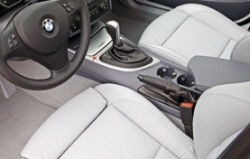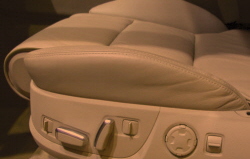I must admit to a bit of a fetish for seat adjustments. Already in this blog I’ve written about adjustable side bolsters and power recline.
Well, it’s time for another installment. A reader recently emailed me, asking me why I don’t more often comment on the amount of room and comfort available to tall people like himself. (The short answer: I’m not tall.) James added that he had once driven a Mercedes where the length of the seat cushion was adjustable, and wondered why this feature wasn’t offered in more cars. Good question.
 The amount of thigh support can be adjusted in a number of ways. The simplest, least costly execution makes the leading section of the seat, generally just a couple inches deep, manually extendable. You’ll find this feature in just about every BMW sport seat, generally as part of a Sport Package. Ford also offered this feature on some sport models back in the 1980s, but hasn’t since then. TrueDelta’s default value for this feature is $50 per seat, so we’re not talking about a lot of money. The downside of this execution is that it leaves a gap between the support and the rest of the seat when the former is extended, and some might find this gap unsightly.
The amount of thigh support can be adjusted in a number of ways. The simplest, least costly execution makes the leading section of the seat, generally just a couple inches deep, manually extendable. You’ll find this feature in just about every BMW sport seat, generally as part of a Sport Package. Ford also offered this feature on some sport models back in the 1980s, but hasn’t since then. TrueDelta’s default value for this feature is $50 per seat, so we’re not talking about a lot of money. The downside of this execution is that it leaves a gap between the support and the rest of the seat when the former is extended, and some might find this gap unsightly.
More often the thigh support will be power adjustable. Usually the entire seat bottom can be powered fore-and-aft independently of the rest of the seat. This implementation can be found in some BMWs, Mercedes, Jaguars, and the Lexus LS. One downside could be that the seat bottom’s bolsters also shift forward. Also, adjustability will be limited or a gap would open up at the rear of the seat cushion. TrueDelta’s default value is $100 per seat.
 The most complex implementation I’ve come across can be found in Audi’s A8 flagship. Here the forward edge of the seat can be extended forward, but only the internal structure moves. The seat upholstery unfurls from beneath the seat to rotate around the internal structure as the latter extends. This way the entire seat bottom doesn’t have to move, and no gap opens up. But this cannot be cheap to implement. TrueDelta nevertheless also values it at $100 per seat.
The most complex implementation I’ve come across can be found in Audi’s A8 flagship. Here the forward edge of the seat can be extended forward, but only the internal structure moves. The seat upholstery unfurls from beneath the seat to rotate around the internal structure as the latter extends. This way the entire seat bottom doesn’t have to move, and no gap opens up. But this cannot be cheap to implement. TrueDelta nevertheless also values it at $100 per seat.
Even though I’m not 6’2″ like James, in many cars I’d appreciate more thigh support, and would gladly pay one-to-two hundred dollars for it. Yet, as far as I can recall it is not available in any U.S.-market car under $30,000. Why not?